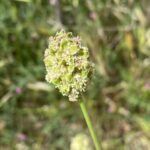Ποτήριο το κονδυλωματοκαλυμμένο
Etymology of Poetrium verrucosum: The name of the genus, "Poterium", derives from the Ancient Greek "ποτήριον" [potirion], which means "tumbler, drinking-cup", alluding to the shape of its hypanthiums on the seed head. The species' name, "verrucosus", derives from Latin and means "covered with warts, rugged" and refers to the warty, rugged look of the seed head.
There are two Poterium kinds in Cyprus, a species and a very rare subspecies.
Poterium verrucosum is an uncommon plant to see in the Cypriot habitat. It is encountered all around the island except in eastern Cyprus, at an altitude of up to 925 metres. On the contrary, Poterium sanguisorba subsp. dictyocarpum exists only in one area of the Troodos Mountains range, at an exact altitude of 1525 metres. Poterium verrucosum primarily grows on open, uncultivated ground and roadsides. Its flowering period is from March until May.
How to identify Poterium verrucosum:
The key to its identification is its fruit. Poterium verrucosum's fruits can be characterised as not angled, or obscurely angled, with their surfaces strongly verrucose-tuberculate, 4.5-6 x 4-5 mm long; their achenes are normally 2-3 in each fruit, 3-4 mm long. On the contrary, Poterium Poterium sanguisorba subsp. dictyocarpum's fruits can be characterised as distinctly 4-angled, with their surfaces reticulate, 2.5-3 x 2-2.5 mm; its achenes are normally 1-2 in each fruit, circa 2-3 mm long.
An extremely important factor in its identification is the fact that Poterium sanguisorba subsp. dictyocarpum has been recorded at an altitude of around 1500 metres only, hence it's an extremely rare plant and it is considered endangered to extinction.


